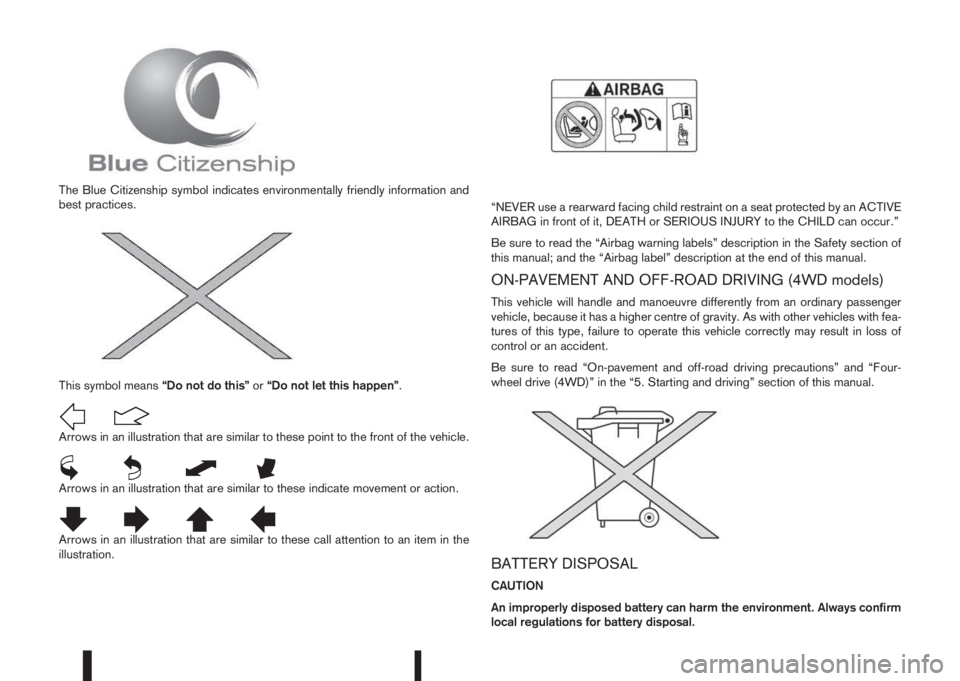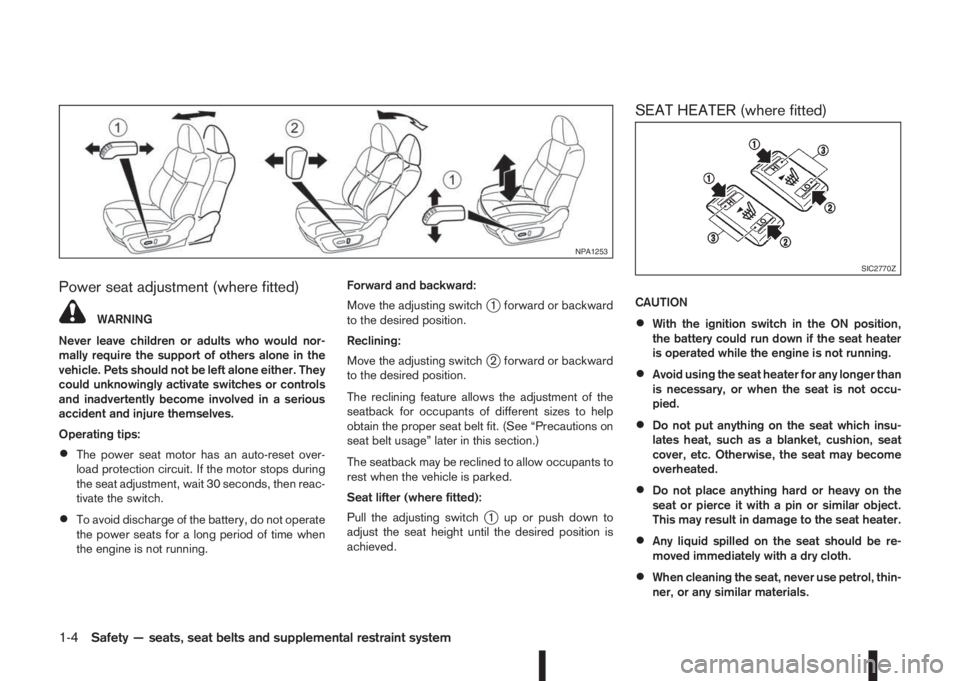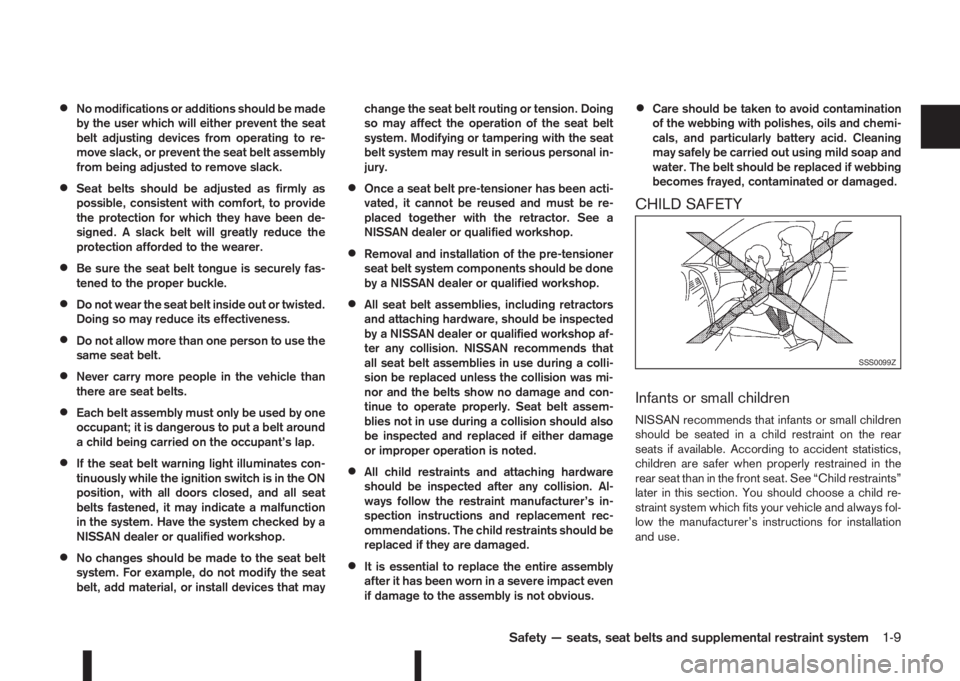Page 3 of 338

The Blue Citizenship symbol indicates environmentally friendly information and
best practices.
This symbol means“Do not do this”or“Do not let this happen”.
Arrows in an illustration that are similar to these point to the front of the vehicle.
Arrows in an illustration that are similar to these indicate movement or action.
Arrows in an illustration that are similar to these call attention to an item in the
illustration.“NEVER use a rearward facing child restraint on a seat protected by an ACTIVE
AIRBAG in front of it, DEATH or SERIOUS INJURY to the CHILD can occur.”
Be sure to read the “Airbag warning labels” description in the Safety section of
this manual; and the “Airbag label” description at the end of this manual.
ON-PAVEMENT AND OFF-ROAD DRIVING (4WD models)
This vehicle will handle and manoeuvre differently from an ordinary passenger
vehicle, because it has a higher centre of gravity. As with other vehicles with fea-
tures of this type, failure to operate this vehicle correctly may result in loss of
control or an accident.
Be sure to read “On-pavement and off-road driving precautions” and “Four-
wheel drive (4WD)” in the “5. Starting and driving” section of this manual.
BATTERY DISPOSAL
CAUTION
An improperly disposed battery can harm the environment. Always confirm
local regulations for battery disposal.
Page 4 of 338
Examples of the batteries that the vehicle contains:
•Vehicle battery
•Remote controller battery (for Intelligent Key and/or Remote keyless entry
system)
•Tyre Pressure Monitoring System (TPMS) sensor battery
•Remote controller battery (for Mobile Entertainment system)
If in doubt, contact your local authority, or a NISSAN dealer, or a qualified work-
shop for advice on disposal.
mBluetooth® is a trademark owned by Bluetooth SIG, Inc.
miPod® is a trademark of Apple Inc.
m
Gracenote® and CDDB are registered trademarks of
Gracenote, Inc. The Gracenote logo and logo type, and
the “Powered by Gracenote” logo are trademarks of
Gracenote.
Page 17 of 338
HRA2DDT ENGINE
1.Engine coolant reservoir (P. 8-6)
2.Window washer/headlight cleaner (where fit-
ted) fluid reservoir (P. 8-15)
3.Brake/clutch fluid reservoir (MT (RHD)
models), Brake fluid reservoir (XTRONIC
transmission (RHD) models) (P. 8-14)
4.Engine oil filler cap (P. 8-8)
5.Engine oil dipstick (P. 8-8)
6.Brake/clutch fluid reservoir (MT (LHD)
models), Brake fluid reservoir (XTRONIC
transmission (LHD) models) (P. 8-14)
7.Battery (P. 8-16)
8.Air cleaner filter (P. 8-23)
9.Fuses/fusible link box (P. 8-25)
NPA1285
ENGINE COMPARTMENT
Illustrated table of contents0-11
Page 18 of 338
MR20DD ENGINE
1.Engine coolant reservoir (P. 8-6)
2.Window washer/headlight cleaner (where fit-
ted) fluid reservoir (P. 8-15)
3.Brake/clutch fluid reservoir (MT (RHD)
models), Brake fluid reservoir (XTRONIC
transmission (RHD) models) (P. 8-14)
4.Engine oil filler cap (P. 8-8)
5.Engine oil dipstick (P. 8-8)
6.Brake/clutch fluid reservoir (MT (LHD)
models), Brake fluid reservoir (XTRONIC
transmission (LHD) models) (P. 8-14)
7.Battery (P. 8-16)
8.Air cleaner filter (P. 8-23)
9.Fuses/fusible link box (P. 8-25)
NPA1286
0-12Illustrated table of contents
Page 19 of 338
K9K ENGINE
1.Engine coolant reservoir (P. 8-6)
2.Window washer/headlight cleaner (where fit-
ted) fluid reservoir (P. 8-15)
3.Brake/clutch fluid reservoir (MT (RHD)
models), (P. 8-14)
4.Engine oil filler cap (P. 8-8)
Engine oil dipstick (P. 8-8)
5.Brake/clutch fluid reservoir (MT (LHD)
models), (P. 8-14)
6.Battery (P. 8-16)
7.Air cleaner filter (P. 8-23)
8.Fuses/fusible link box (P. 8-25)
NPA1283
Illustrated table of contents0-13
Page 20 of 338
R9M ENGINE
1.Engine coolant reservoir (P. 8-6)
2.Window washer/headlight cleaner (where fit-
ted) fluid reservoir (P. 8-15)
3.Brake/clutch fluid reservoir (MT (RHD)
models), Brake fluid reservoir (XTRONIC
transmission (RHD) models) (P. 8-14)
4.Engine oil dipstick (P. 8-8)
5.Engine oil filler cap (P. 8-8)
6.Brake/clutch fluid reservoir (MT (LHD)
models), Brake fluid reservoir (XTRONIC
transmission (LHD) models) (P. 8-14)
7.Battery (P. 8-16)
8.Air cleaner filter (P. 8-23)
9.Fuses/fusible link box (P. 8-25)
NPA1284
0-14Illustrated table of contents
Page 24 of 338

Power seat adjustment (where fitted)
WARNING
Never leave children or adults who would nor-
mally require the support of others alone in the
vehicle. Pets should not be left alone either. They
could unknowingly activate switches or controls
and inadvertently become involved in a serious
accident and injure themselves.
Operating tips:
•The power seat motor has an auto-reset over-
load protection circuit. If the motor stops during
the seat adjustment, wait 30 seconds, then reac-
tivate the switch.
•To avoid discharge of the battery, do not operate
the power seats for a long period of time when
the engine is not running.Forward and backward:
Move the adjusting switch
j1 forward or backward
to the desired position.
Reclining:
Move the adjusting switch
j2 forward or backward
to the desired position.
The reclining feature allows the adjustment of the
seatback for occupants of different sizes to help
obtain the proper seat belt fit. (See “Precautions on
seat belt usage” later in this section.)
The seatback may be reclined to allow occupants to
rest when the vehicle is parked.
Seat lifter (where fitted):
Pull the adjusting switch
j1 up or push down to
adjust the seat height until the desired position is
achieved.
SEAT HEATER (where fitted)
CAUTION
•With the ignition switch in the ON position,
the battery could run down if the seat heater
is operated while the engine is not running.
•Avoid using the seat heater for any longer than
is necessary, or when the seat is not occu-
pied.
•Do not put anything on the seat which insu-
lates heat, such as a blanket, cushion, seat
cover, etc. Otherwise, the seat may become
overheated.
•Do not place anything hard or heavy on the
seat or pierce it with a pin or similar object.
This may result in damage to the seat heater.
•Any liquid spilled on the seat should be re-
moved immediately with a dry cloth.
•When cleaning the seat, never use petrol, thin-
ner, or any similar materials.
NPA1253
SIC2770Z
1-4Safety — seats, seat belts and supplemental restraint system
Page 29 of 338

•No modifications or additions should be made
by the user which will either prevent the seat
belt adjusting devices from operating to re-
move slack, or prevent the seat belt assembly
from being adjusted to remove slack.
•Seat belts should be adjusted as firmly as
possible, consistent with comfort, to provide
the protection for which they have been de-
signed. A slack belt will greatly reduce the
protection afforded to the wearer.
•Be sure the seat belt tongue is securely fas-
tened to the proper buckle.
•Do not wear the seat belt inside out or twisted.
Doing so may reduce its effectiveness.
•Do not allow more than one person to use the
same seat belt.
•Never carry more people in the vehicle than
there are seat belts.
•Each belt assembly must only be used by one
occupant; it is dangerous to put a belt around
a child being carried on the occupant’s lap.
•If the seat belt warning light illuminates con-
tinuously while the ignition switch is in the ON
position, with all doors closed, and all seat
belts fastened, it may indicate a malfunction
in the system. Have the system checked by a
NISSAN dealer or qualified workshop.
•No changes should be made to the seat belt
system. For example, do not modify the seat
belt, add material, or install devices that maychange the seat belt routing or tension. Doing
so may affect the operation of the seat belt
system. Modifying or tampering with the seat
belt system may result in serious personal in-
jury.
•Once a seat belt pre-tensioner has been acti-
vated, it cannot be reused and must be re-
placed together with the retractor. See a
NISSAN dealer or qualified workshop.
•Removal and installation of the pre-tensioner
seat belt system components should be done
by a NISSAN dealer or qualified workshop.
•All seat belt assemblies, including retractors
and attaching hardware, should be inspected
by a NISSAN dealer or qualified workshop af-
ter any collision. NISSAN recommends that
all seat belt assemblies in use during a colli-
sion be replaced unless the collision was mi-
nor and the belts show no damage and con-
tinue to operate properly. Seat belt assem-
blies not in use during a collision should also
be inspected and replaced if either damage
or improper operation is noted.
•All child restraints and attaching hardware
should be inspected after any collision. Al-
ways follow the restraint manufacturer’s in-
spection instructions and replacement rec-
ommendations. The child restraints should be
replaced if they are damaged.
•It is essential to replace the entire assembly
after it has been worn in a severe impact even
if damage to the assembly is not obvious.
•Care should be taken to avoid contamination
of the webbing with polishes, oils and chemi-
cals, and particularly battery acid. Cleaning
may safely be carried out using mild soap and
water. The belt should be replaced if webbing
becomes frayed, contaminated or damaged.
CHILD SAFETY
Infants or small children
NISSAN recommends that infants or small children
should be seated in a child restraint on the rear
seats if available. According to accident statistics,
children are safer when properly restrained in the
rear seat than in the front seat. See “Child restraints”
later in this section. You should choose a child re-
straint system which fits your vehicle and always fol-
low the manufacturer’s instructions for installation
and use.
SSS0099Z
Safety — seats, seat belts and supplemental restraint system1-9